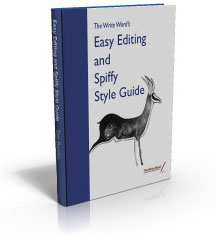
red riding hood, via wikipedia
Once upon a time….No wait, not that kind of story. I mean how to tell a business story (a story about your company, and how you started it and how it grew).
Not the kind of business story where you brag about the five new people you just hired, or the free snacks in your employee lunchroom.
You want a story story that’s meaningful to people reading your web site or your blog post or your ad. A story that draws readers in and increases their interest in your business (and your services).
How to tell a business story
An ad (or a web site) are really stories. A story that you tell about yourself, your company, and your customers. A story about why you’re different.
Here’s an example of a (fictional) poor business story:
The Acme Landscape Company has been in business for 47 years. We pride ourselves on great service to our customers. We can work on business properties or homes. Sign up for our gardening newsletter and get monthly tips.
They may be great landscapers, but their story is lousy. There’s no reason to care that they’ve been in business a long time. They don’t seem to specialize in anything, and they’ve asked me to sign up for their gardening newsletter without telling me much about what I’ll get when I do.
Good business stories draw people in
A good business story, on the other hand, packs an emotional punch. It’s interesting, it incites curiosity, and it’s relevant.
Before writing your own story, ask yourself, is it something my customers (or potential customers) care about? Does it attract attention? Or is it a big snooze?
What if that landscape company had said,
“We believe in green thumbs and we’ll show you how to get one.”
Or, how about something like this:
“It started with a single seed. One single tomato seed that became an empire.”
Or this,
“Insurance agents you’ll actually enjoy talking to.”
These are essentially, mini-mission statements. The story idea also applies when you’re telling stories about how your company got started, or how you’ve helped your customers.
Most about pages are boring. Instead of going on about your years in business or your credentials, explain how you started in a garage (and grew into a multi-billion dollar company). Or highlight how a chance encounter in a parking lot led to a big idea.
Borrow Your Business Story from Movies and Books
Use the elements we associate with fairy tales, movies, and novels: metaphors, the hero’s journey, reversals of fortune, and conflict. This is one version that Pixar uses:
Once upon a time there was ___. Every day, ___. One day ___. Because of that, ___. Because of that, ___. Until finally _
Once upon a time, there was a little girl called Red Riding Hood. One day, she set off to visit her grandma. Because of that, she met a wolf in the woods. The wolf ran ahead to grandma’s house, swallowed her, and then lay in wait for Red Riding Hood. When she arrived, he ate her too.
Because the wolf fell asleep and snored after he ate, a passing huntsman went in to check on grandma. He saw the wolf, and was about to shoot it when he realized the wolf might have eaten grandma. Finally, he slit open the wolf’s stomach and freed them both.
When you write your own story, share the obstacles you overcame, and how you succeeded. Describe how you help your customers vanquish their own wolves, and how they feel about that. It’s even better if you can show others how to do the same thing (and have proof).
Much more interesting, isn’t it?
Do you have a business story?
What is it?
 I hate typos. And editing flubs. And garbled sentences that look like they spent too much time in the spin cycle. If you hate them too, get your hands on Tom Bentley’s spiffy new style and editing guide. It includes:
I hate typos. And editing flubs. And garbled sentences that look like they spent too much time in the spin cycle. If you hate them too, get your hands on Tom Bentley’s spiffy new style and editing guide. It includes:



